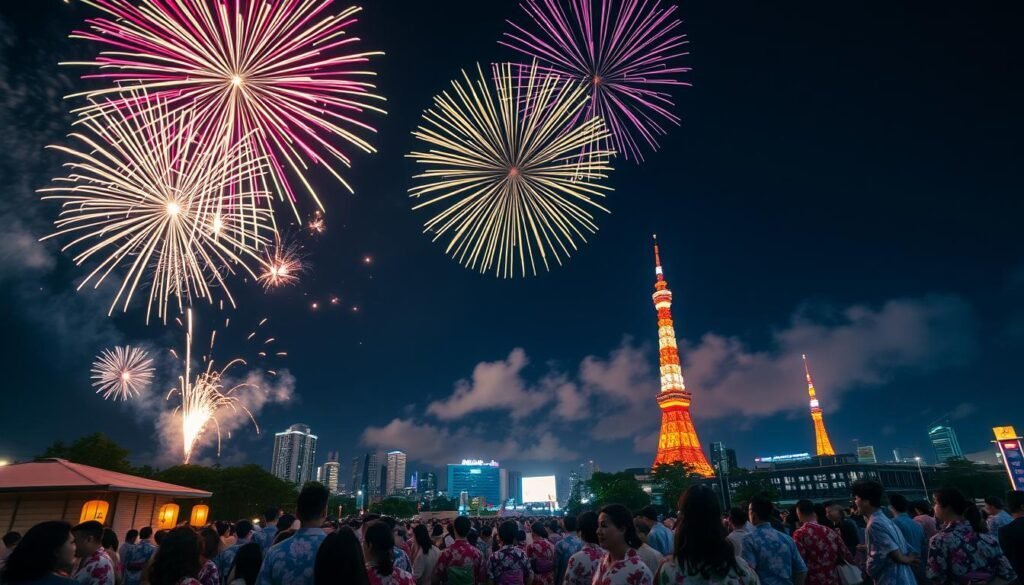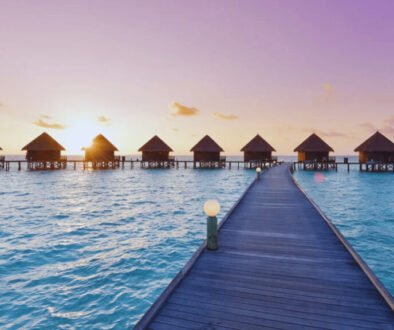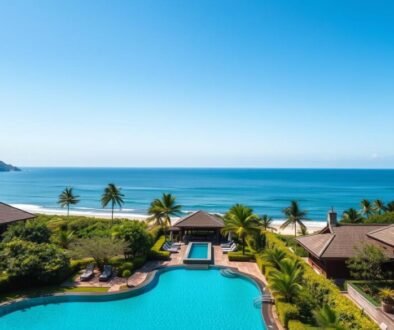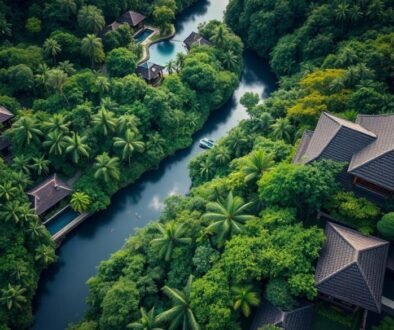1-Week Japan Summer Itinerary: The Ultimate Guide for First-Time Visitors
This article may contain affiliate links. If you click on these links and make a purchase, we may receive a small commission at no extra cost to you. This helps support our website and allows us to continue to produce content like this. Thank you for your support!
Planning a summer trip to Japan? You’re in for an incredible experience filled with vibrant festivals, delicious seasonal foods, and unforgettable cultural encounters. While summer in Japan brings heat and humidity, it also offers unique opportunities that other seasons don’t – from spectacular fireworks festivals to less crowded attractions and better travel deals. This carefully crafted 1-week Japan summer itinerary balances must-see destinations with seasonal highlights and practical tips to help you make the most of your journey.
Experience the magic of Japan’s spectacular summer fireworks festivals during your one-week trip
Essential Pre-Trip Planning for Summer in Japan
Before diving into the day-by-day itinerary, let’s cover some crucial information to ensure your summer trip to Japan goes smoothly. Summer (June to August) brings unique considerations that differ from other seasons.
Summer Weather in Japan: What to Expect
Japan’s summer is characterized by heat and humidity, with temperatures typically ranging from 20–32°C (66–88°F). The rainy season (tsuyu) usually runs from early June to mid-July, but don’t worry – rain typically doesn’t last all day and many attractions have indoor options.
| Month | Average Temperature | Rainfall | Humidity | Notes |
| June | 20-26°C (68-79°F) | 167mm (6.6in) | 75% | Rainy season begins, cooler than July/August |
| July | 24-29°C (75-84°F) | 153mm (6in) | 80% | Rainy season ends, major festivals begin |
| August | 26-31°C (79-88°F) | 168mm (6.6in) | 73% | Peak festival season, hottest month |
Japan Rail Pass: Your Transportation Solution
For a 1-week itinerary covering multiple cities, the Japan Rail Pass is highly recommended. This cost-effective pass allows unlimited travel on JR trains, including the high-speed Shinkansen bullet trains. Purchase your pass before arriving in Japan, as it’s only available to foreign visitors and must be ordered in advance.

The Shinkansen bullet train will be your primary mode of transportation between cities
Reserve Your Japan Rail Pass
Save time and money by securing your Japan Rail Pass before your trip. Current prices start at ¥29,650 (approximately $200) for a 7-day pass.
Summer Packing Essentials
Packing appropriately for Japan’s summer climate will significantly enhance your comfort during your trip. Here are the must-have items:
- Lightweight, breathable clothing (cotton, linen)
- Portable fan or handheld mister
- UV-blocking umbrella (for sun and rain)
- Quick-dry towel or handkerchief (for wiping sweat)
- Refillable water bottle
- Comfortable walking shoes
- High SPF sunscreen
- Insect repellent
- Portable Wi-Fi or SIM card
- Power bank for your devices
- Light rain jacket or poncho
- Small backpack for day trips
Pro Tip: Japan has excellent convenience stores (konbini) where you can purchase cooling products like body wipes, cooling sprays, and special summer drinks if needed during your trip.
Day 1: Arrival in Tokyo & First Explorations
Your Japanese adventure begins! Most international flights arrive at Narita Airport, located about 60km from central Tokyo. After a long flight, this first day is designed to help you settle in while still experiencing some of Tokyo’s highlights.
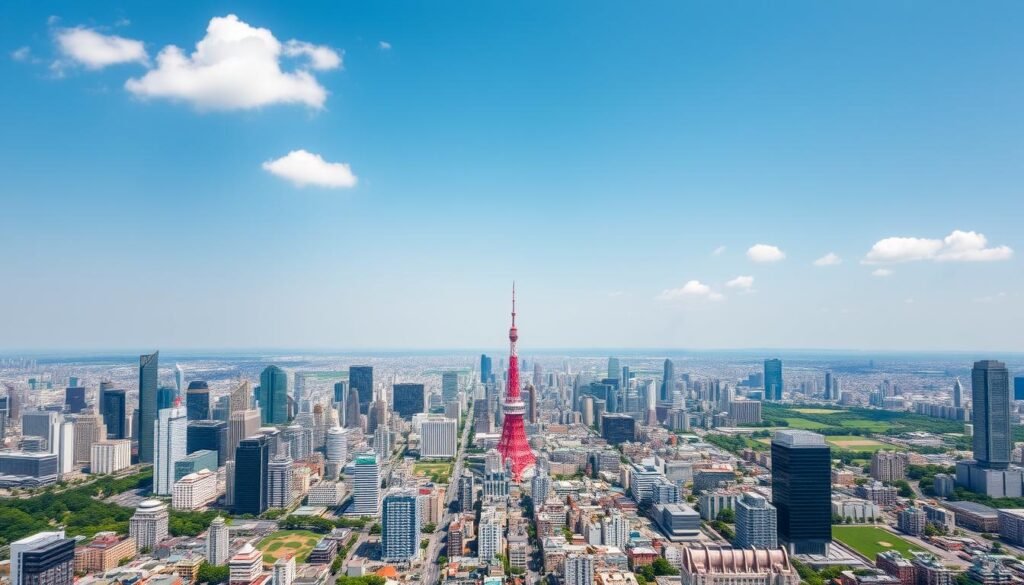
Tokyo’s impressive skyline welcomes you to Japan’s vibrant capital city
Morning: Airport Arrival & Essential Setup
After landing at Narita Airport, complete these important first steps:
- Exchange your Japan Rail Pass voucher at the JR East Travel Service Center (located on the B1 floor of Terminals 1 and 2-3)
- Pick up your pre-ordered pocket WiFi or SIM card (recommended for navigation)
- Take the Narita Express (N’EX) train to Tokyo Station (approximately 60 minutes)
Summer Travel Tip: Activate your Japan Rail Pass starting from Day 2 if you arrive late in the day. This maximizes your 7-day pass usage for intercity travel. Pay separately for the Narita Express on arrival day.
Afternoon: Check-in & Asakusa Exploration
After reaching Tokyo Station, head to your hotel to check in and freshen up. For your first afternoon in Japan, Asakusa offers a perfect introduction to Japanese culture without being overwhelming.
- Visit the magnificent Sensō-ji Temple, Tokyo’s oldest Buddhist temple
- Explore Nakamise Shopping Street for souvenirs and street food
- Cool off with a refreshing kakigōri (Japanese shaved ice dessert)
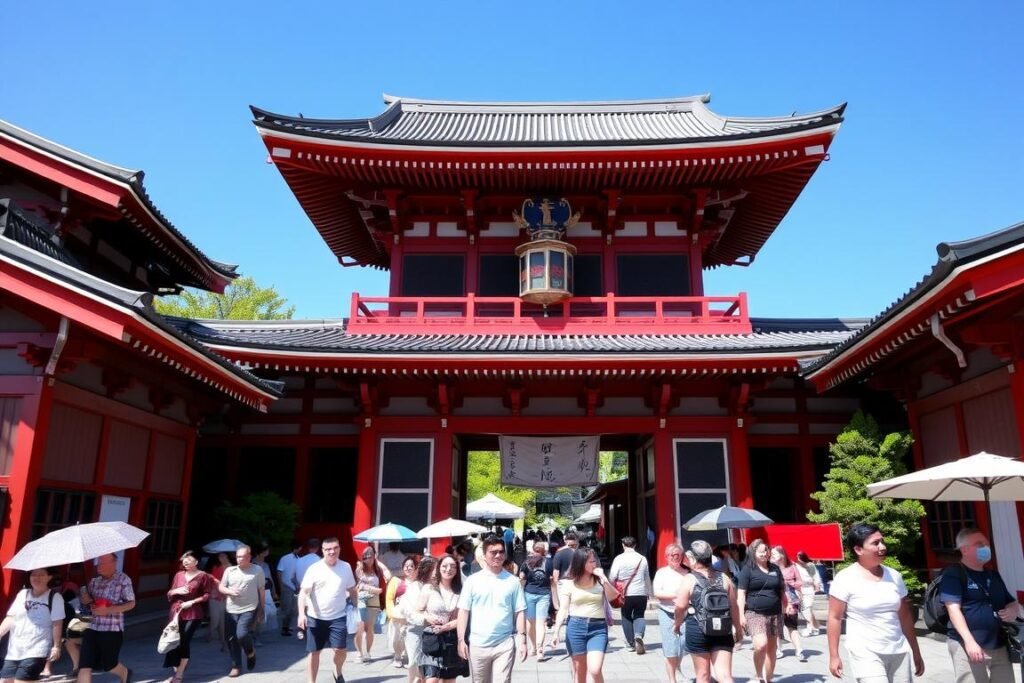
Sensō-ji Temple in Asakusa offers a perfect introduction to Japan’s cultural heritage
Evening: Tokyo Skytree & Dinner
As the day cools down, head to nearby Tokyo Skytree for spectacular evening views of the city. Then enjoy your first authentic Japanese dinner at one of the many restaurants in the area.
Recommended Accommodation in Tokyo
For your three nights in Tokyo, consider these well-located options with good air conditioning (essential for summer):
- Budget: HOTEL MYSTAYS Asakusa (from $70/night)
- Mid-range: Hotel Metropolitan Tokyo Marunouchi (from $150/night)
- Luxury: The Gate Hotel Tokyo by Hulic (from $250/night)
Day 2: Tokyo’s Modern Highlights
Today you’ll explore Tokyo’s more modern districts, experiencing the city’s futuristic side while finding ways to beat the summer heat.
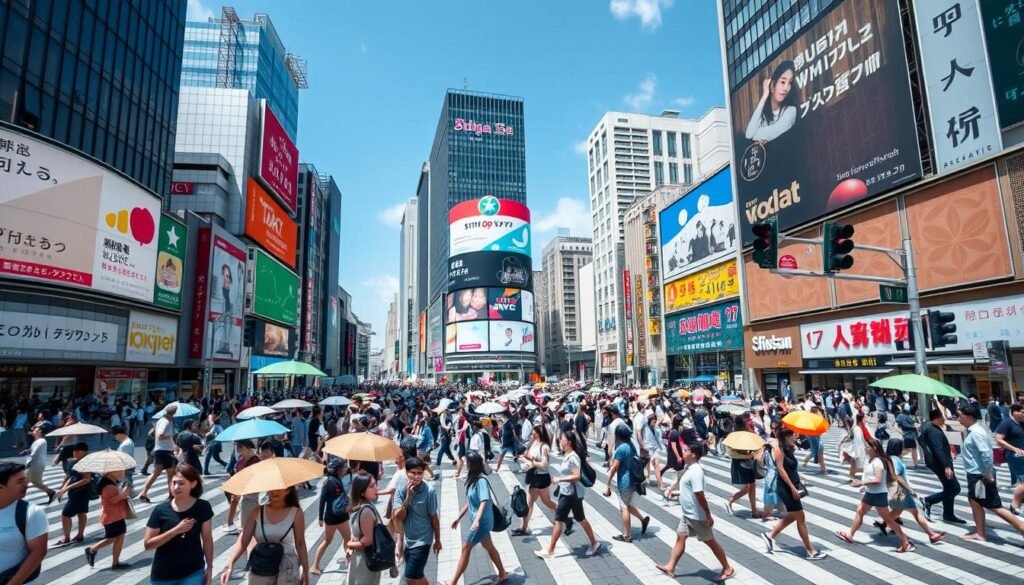
Experience the organized chaos of Shibuya Crossing, one of Tokyo’s most iconic spots
Morning: Harajuku & Meiji Shrine
Start your day with a perfect balance of nature and pop culture:
- Visit the serene Meiji Shrine, set in a forested area that offers natural cooling
- Stroll down Takeshita Street in Harajuku, the epicenter of Japanese youth fashion
- Try unique summer treats like colorful crepes or rainbow cotton candy
Afternoon: Shibuya & Shinjuku
After lunch, explore two of Tokyo’s most vibrant districts:
- Experience the famous Shibuya Crossing, the world’s busiest pedestrian intersection
- Visit the Hachikō statue, commemorating Japan’s most loyal dog
- Explore air-conditioned department stores in Shinjuku for a break from the heat
- Check out the Tokyo Metropolitan Government Building’s free observation deck for panoramic city views
Summer Cooling Tip: Department stores and shopping malls in Japan have excellent air conditioning. They make perfect afternoon retreats when the summer heat peaks between 1-3 PM.
Evening: Tokyo Summer Night Views
Summer evenings in Tokyo offer special experiences:
- Enjoy dinner at an air-conditioned restaurant in Shinjuku
- Experience the neon lights of Kabukicho entertainment district
- If your visit coincides with a hanabi (fireworks) event, check the schedule and find a good viewing spot
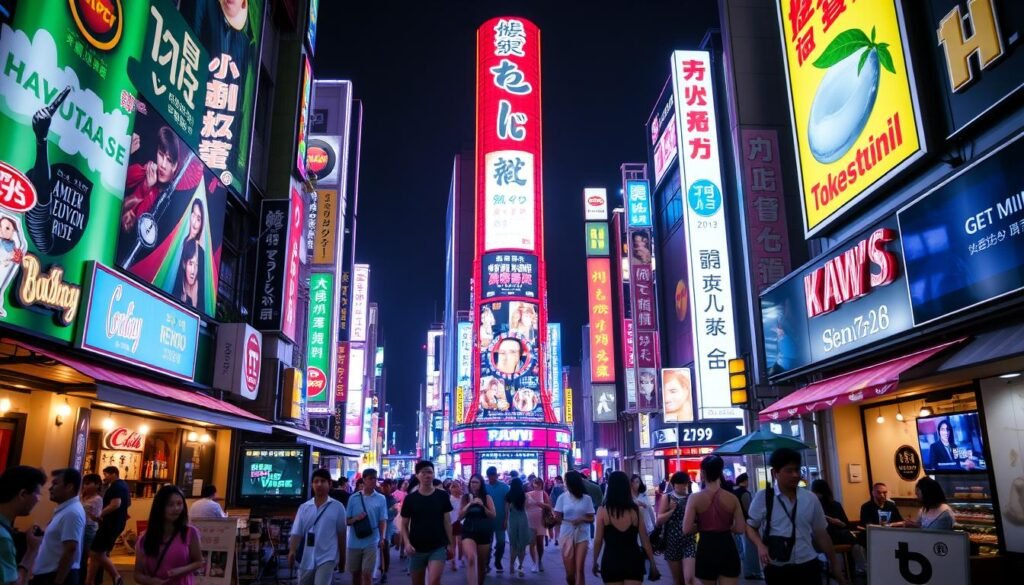
Shinjuku’s neon landscape comes alive after dark, offering a cooler evening experience
Day 3: Day Trip to Mt. Fuji Area
Escape the city heat with a refreshing day trip to the Mt. Fuji area. The region around Japan’s iconic mountain offers cooler temperatures and stunning natural scenery.
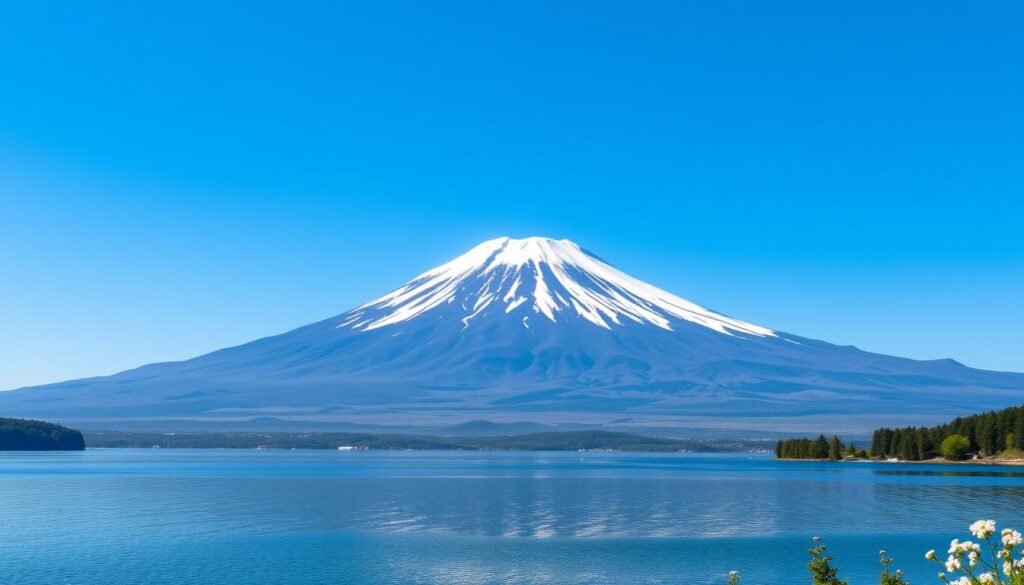
Lake Kawaguchiko offers one of the best views of Mt. Fuji during summer months
Morning: Journey to Kawaguchiko
Use your Japan Rail Pass to make this journey:
- Take the JR Chuo Line from Tokyo to Otsuki Station (approximately 70 minutes)
- Transfer to the Fujikyu Railway Line to Kawaguchiko Station (approximately 55 minutes)
- Note: The Fujikyu Railway is not covered by the JR Pass, so you’ll need to purchase this portion separately (about ¥1,540)
Afternoon: Lake Kawaguchiko Exploration
Once you arrive, there are several ways to enjoy the Mt. Fuji area:
- Take the Kawaguchiko Sightseeing Bus (Red Line) for a loop around the lake
- Visit the Kachi Kachi Ropeway for elevated views of Mt. Fuji and the lake
- Explore the Kawaguchiko Music Forest or Oishi Park for beautiful summer flowers with Mt. Fuji as a backdrop
- Cool off with a boat ride on Lake Kawaguchiko

Summer brings beautiful lavender fields to the Fuji Five Lakes region
Mt. Fuji Climbing Season: If you’re interested in climbing Mt. Fuji, the official climbing season runs from early July to early September. However, this requires a full day and proper preparation. For a taste of the mountain without the full climb, consider visiting the Fuji Subaru Line 5th Station, accessible by bus from Kawaguchiko Station.
Evening: Return to Tokyo
Head back to Tokyo in the evening, following the same route in reverse. If you have energy upon your return, consider exploring the Yurakucho or Ginza areas near Tokyo Station for dinner.
Day 4: Tokyo to Kyoto & First Impressions
Today you’ll travel from Tokyo to Kyoto, Japan’s cultural heart and former imperial capital. The contrast between Tokyo’s modernity and Kyoto’s traditional atmosphere makes for a fascinating transition.
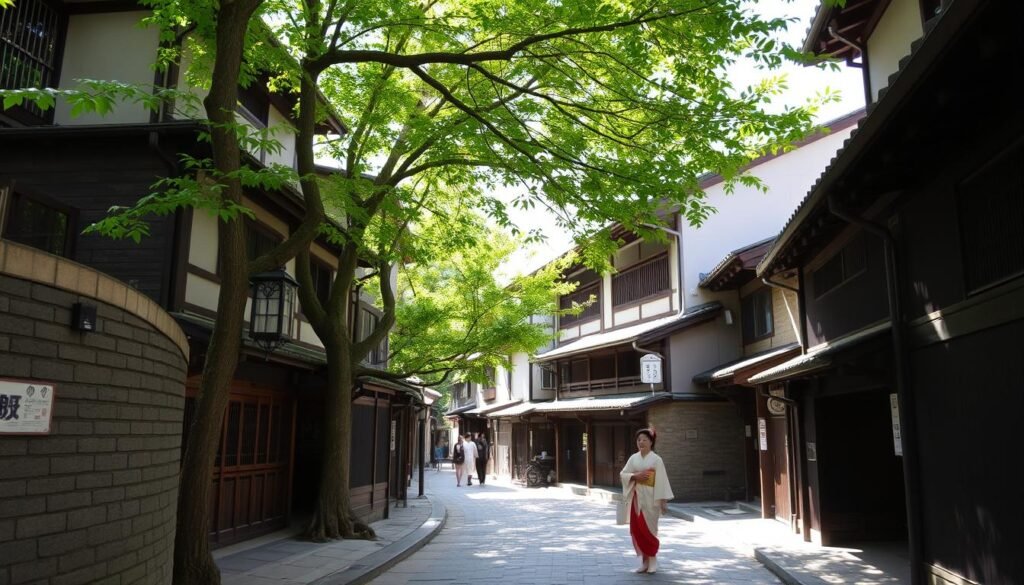
Kyoto’s traditional streets offer a striking contrast to Tokyo’s modern cityscape
Morning: Shinkansen to Kyoto
Check out of your Tokyo hotel and head to Tokyo Station for your bullet train journey:
- Take the Hikari or Kodama Shinkansen from Tokyo to Kyoto (covered by JR Pass)
- The journey takes approximately 2.5 hours
- Consider reserving seats in advance at the JR ticket office
Travel Tip: When boarding the Shinkansen, look for your car number on the platform. The trains stop precisely at marked positions, making boarding efficient. Store large luggage in the designated areas at the end of each car.
Afternoon: Arrive in Kyoto & Explore Higashiyama
After arriving at Kyoto Station and checking into your hotel:
- Visit the historic Higashiyama district, one of Kyoto’s best-preserved areas
- Explore Kiyomizu-dera Temple, offering panoramic views of Kyoto
- Stroll down atmospheric Ninenzaka and Sannenzaka slopes
- Cool off with a matcha ice cream or cold green tea along the way
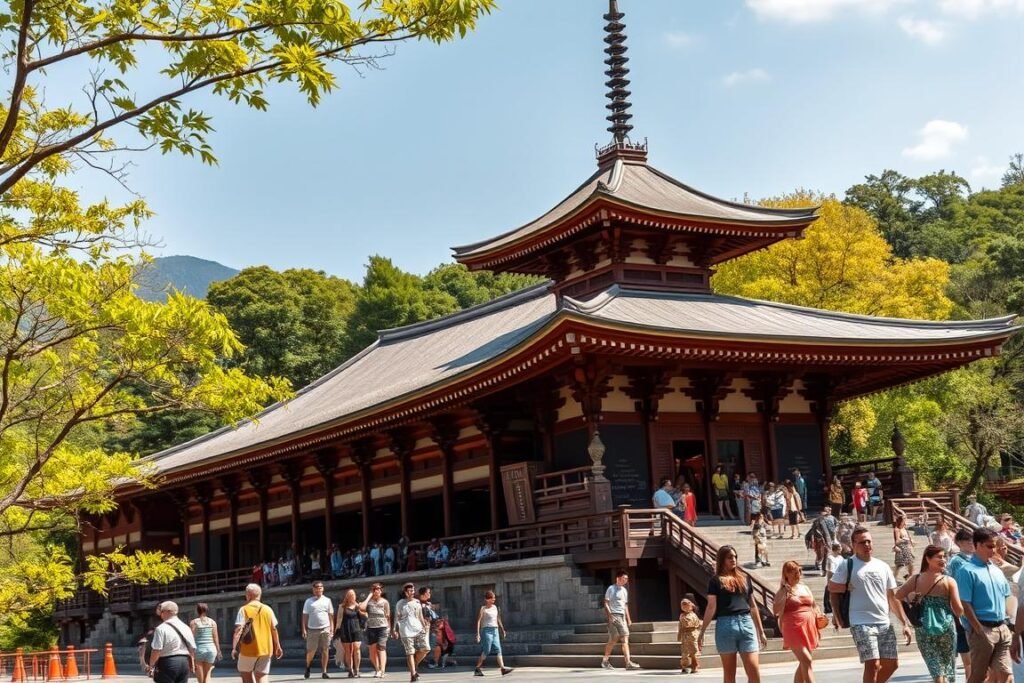
Kiyomizu-dera Temple offers stunning views of Kyoto and cooling forest breezes
Evening: Gion District
As evening approaches, explore Kyoto’s famous geisha district:
- Walk through the atmospheric streets of Gion at dusk
- Look for geiko (Kyoto’s geisha) and maiko (apprentice geisha) heading to evening appointments
- Enjoy dinner at a traditional restaurant along Pontocho Alley, some with riverside seating that’s especially pleasant in summer
Recommended Accommodation in Kyoto
For your three nights in Kyoto, consider these well-located options:
- Budget: Sotetsu Fresa Inn Kyoto-Hachijoguchi (from $80/night)
- Mid-range: Hotel Granvia Kyoto (from $180/night)
- Traditional: Ryokan Shimizu (from $120/night) – experience a traditional Japanese inn
Day 5: Kyoto’s Cultural Treasures
Today is dedicated to exploring Kyoto’s most iconic cultural sites, with strategic planning to avoid the midday heat.
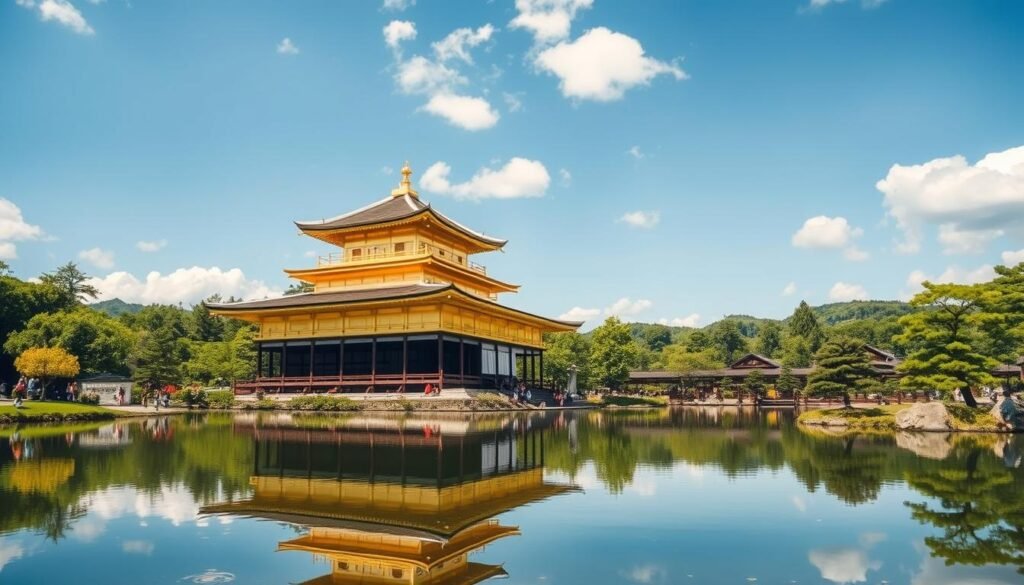
Kinkaku-ji (Golden Pavilion) is one of Kyoto’s most photographed landmarks
Morning: Northwestern Kyoto Temples
Start early to beat the heat and crowds:
- Visit Kinkaku-ji (Golden Pavilion), best seen in morning light
- Explore nearby Ryoan-ji Temple, famous for its zen rock garden
- Stop at Ninna-ji Temple with its beautiful pagoda and gardens
Afternoon: Arashiyama Bamboo Grove
After lunch, head to western Kyoto:
- Take the JR San-in Line to Saga-Arashiyama Station (covered by JR Pass)
- Walk through the famous Arashiyama Bamboo Grove, naturally cooler due to shade
- Visit Tenryu-ji Temple and its beautiful garden
- Consider a relaxing boat ride on the Hozugawa River for a refreshing experience
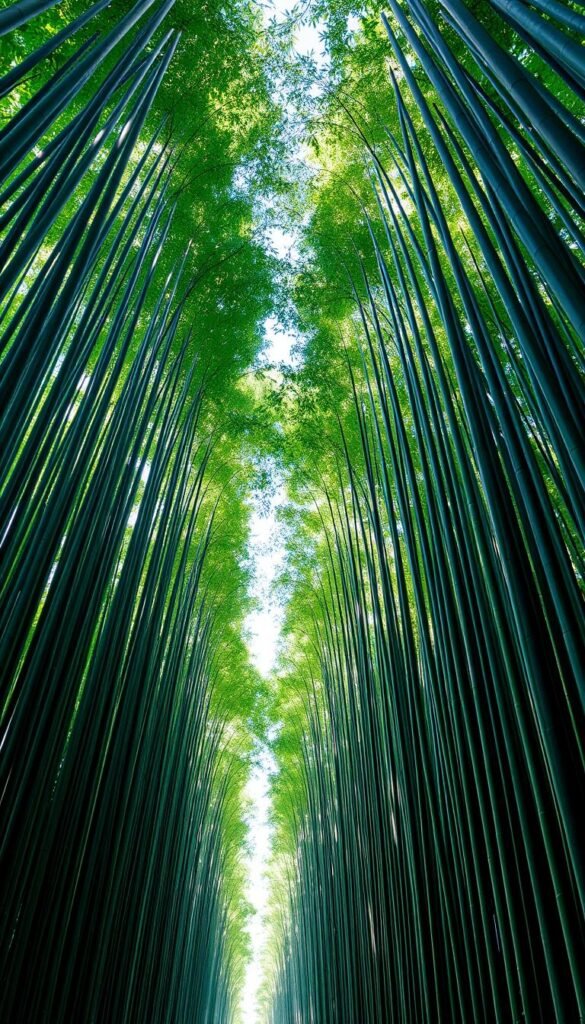
The Arashiyama Bamboo Grove provides natural cooling with its dense shade
Summer Cooling Tip: The Kamogawa River in central Kyoto has restaurants with kawadoko (riverside dining platforms) where you can enjoy meals while feeling the natural cooling effect of the river. These are especially popular in summer!
Evening: Kyoto Summer Night Illuminations
During summer, several Kyoto temples offer special evening illuminations:
- Check if Kiyomizu-dera or Kodai-ji temples are offering summer light-ups
- Experience yuka dining (outdoor platforms) along the Kamogawa River
- Try summer specialties like hiyashi chuka (cold ramen) or unagi (eel, traditionally eaten in summer)
Day 6: Day Trip to Nara
Today you’ll take a short trip to nearby Nara, Japan’s first permanent capital and home to friendly sacred deer and impressive temples.
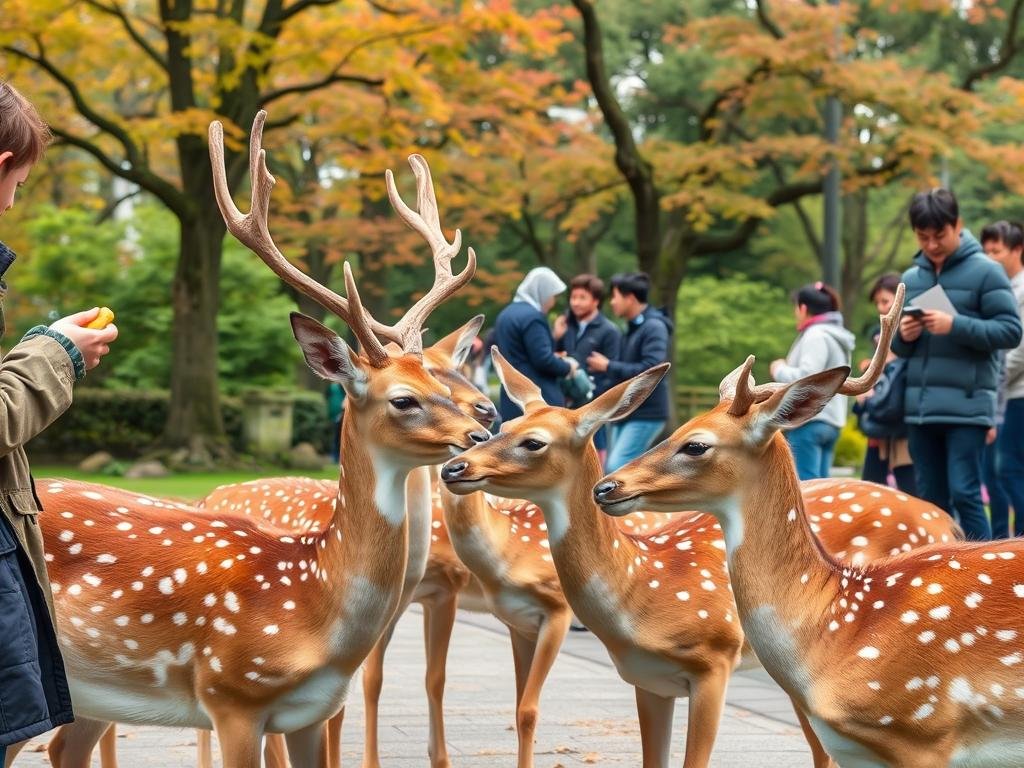
Nara’s friendly sacred deer are a highlight for visitors of all ages
Morning: Journey to Nara
From Kyoto to Nara:
- Take the JR Nara Line from Kyoto Station to Nara Station (45 minutes, covered by JR Pass)
- Alternatively, take the Kintetsu Line from Kyoto Station to Kintetsu-Nara Station for a slightly faster route (35 minutes, not covered by JR Pass)
Afternoon: Nara Park Exploration
Spend the day exploring Nara’s compact historical area:
- Visit Todai-ji Temple, housing the Great Buddha (Daibutsu) in one of the world’s largest wooden buildings
- Interact with the sacred deer in Nara Park (deer crackers available for purchase)
- Explore Kasuga Taisha Shrine with its famous stone lanterns
- Visit the Nara National Museum if you need a break from the heat
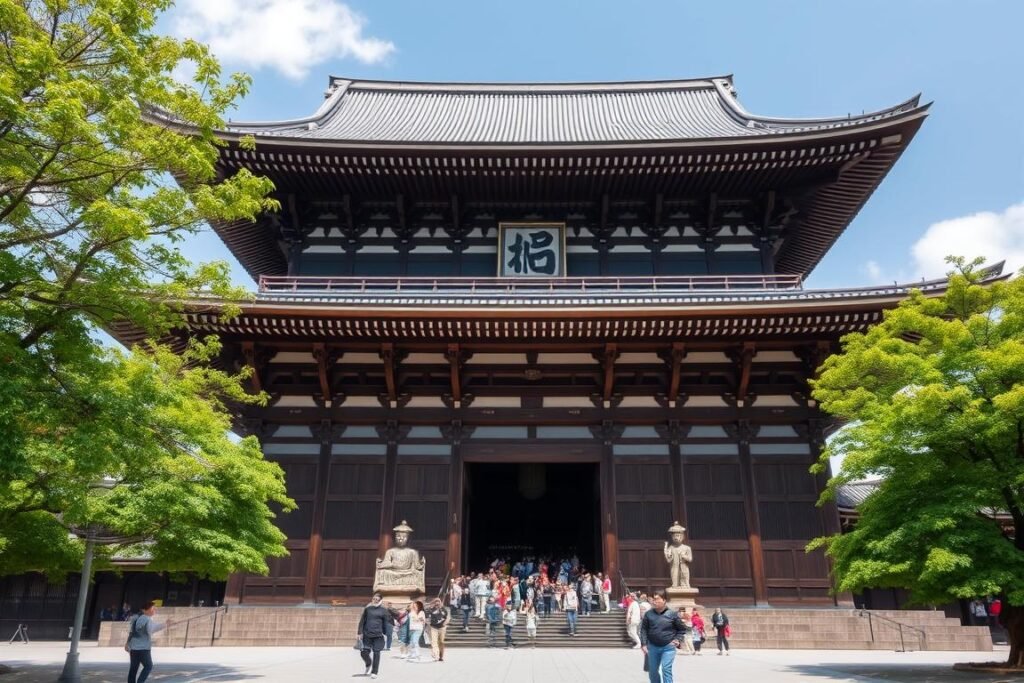
Todai-ji Temple houses one of the world’s largest bronze Buddha statues
Summer Hydration Tip: Nara Park has limited shade in some areas. Carry a water bottle and use the free water refill stations located throughout the park. Many vending machines also sell sports drinks with electrolytes to help prevent dehydration.
Evening: Return to Kyoto
Head back to Kyoto in the evening, following the same route you took in the morning. Consider trying Kyoto’s summer specialty, nagashi sōmen (flowing noodles), for dinner.
Day 7: Kyoto to Osaka & Departure Preparations
On your final full day, experience vibrant Osaka before preparing for your departure the next day.
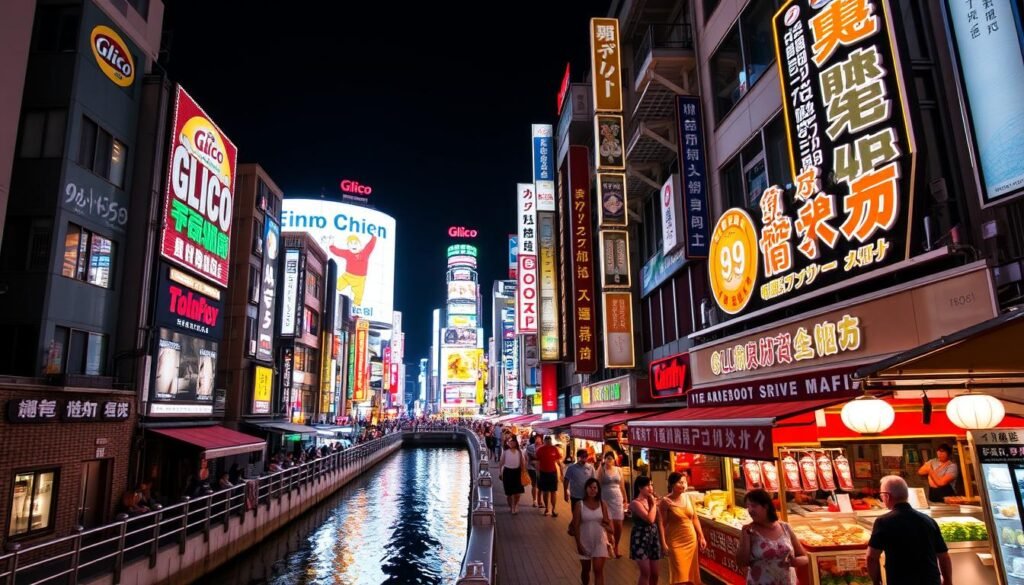
Osaka’s lively Dotonbori district comes alive with neon lights and delicious street food
Morning: Travel to Osaka
Check out of your Kyoto hotel and head to Osaka:
- Take the JR Special Rapid Service from Kyoto Station to Osaka Station (30 minutes, covered by JR Pass)
- Store your luggage in coin lockers at Osaka Station
Afternoon: Osaka Castle & Umeda Sky Building
Explore some of Osaka’s highlights:
- Visit Osaka Castle and its surrounding park (the air-conditioned museum inside offers a cooling break)
- Head to the Umeda Sky Building for panoramic views from the Floating Garden Observatory
- Explore the underground shopping malls around Osaka Station (perfect for escaping the heat)
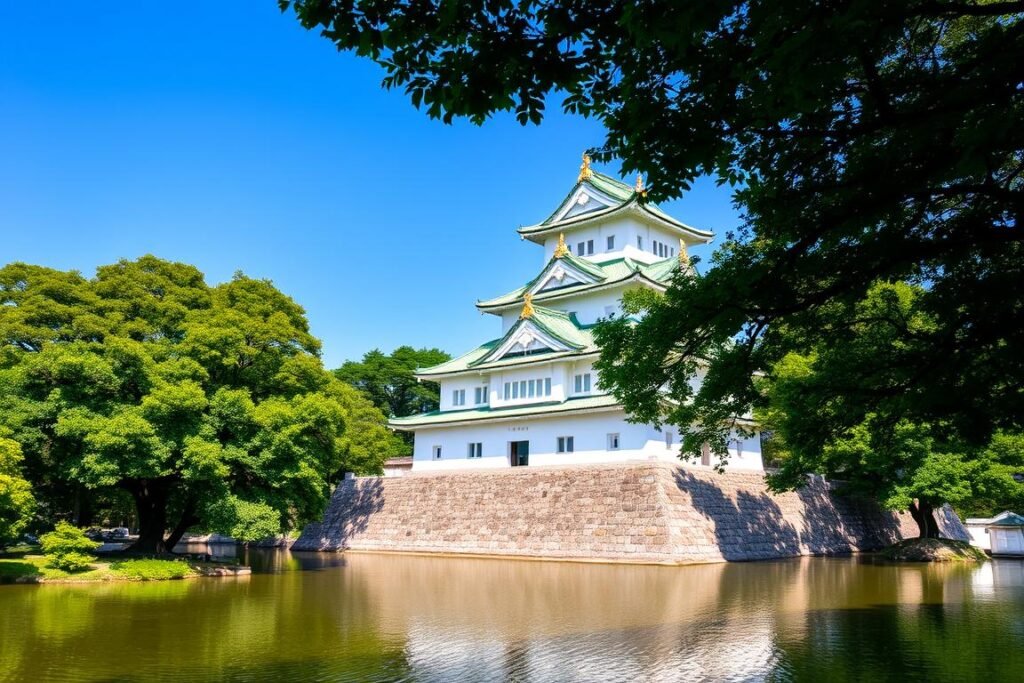
Osaka Castle is surrounded by a large park that offers shady spots during summer
Evening: Dotonbori & Osaka Street Food
Experience Osaka’s famous food culture:
- Explore the lively Dotonbori area with its dazzling neon signs
- Try Osaka street food specialties like takoyaki (octopus balls), okonomiyaki (savory pancakes), and kushikatsu (fried skewers)
- Cool off with a summer kakigōri (shaved ice dessert) with various flavored syrups
Summer Festival Tip: If your visit coincides with the Tenjin Matsuri (July 24-25), one of Japan’s largest summer festivals, adjust your schedule to experience this spectacular event featuring boat processions and fireworks.
Late Evening: Return to Your Final Night’s Accommodation
Depending on your departure plans:
- Return to Kyoto for your final night if your flight leaves from Kansai International Airport (KIX)
- Consider staying at an airport hotel near KIX if you have an early morning flight
- If departing from Tokyo, take an evening Shinkansen back to Tokyo
Recommended Accommodation in Osaka
If you choose to stay in Osaka for your final night:
- Budget: Osaka Guesthouse HIVE (from $60/night)
- Mid-range: Hotel Granvia Osaka (from $120/night)
- Airport Access: Hotel Nikko Kansai Airport (from $150/night)
Budget Breakdown for a 1-Week Summer Trip to Japan
Planning your finances is an important part of trip preparation. Here’s a breakdown of what you can expect to spend during your 1-week summer journey in Japan.
| Expense Category | Budget Option | Mid-Range Option | Luxury Option |
| Accommodation (6 nights) | ¥36,000 ($240) | ¥90,000 ($600) | ¥180,000 ($1,200) |
| Transportation (incl. JR Pass) | ¥35,000 ($235) | ¥45,000 ($300) | ¥60,000 ($400) |
| Food & Drinks | ¥30,000 ($200) | ¥60,000 ($400) | ¥120,000 ($800) |
| Attractions & Activities | ¥15,000 ($100) | ¥30,000 ($200) | ¥60,000 ($400) |
| Shopping & Souvenirs | ¥15,000 ($100) | ¥30,000 ($200) | ¥75,000 ($500) |
| Miscellaneous | ¥9,000 ($60) | ¥15,000 ($100) | ¥30,000 ($200) |
| Total (per person) | ¥140,000 ($935) | ¥270,000 ($1,800) | ¥525,000 ($3,500) |
Summer Budget Tip: Summer is considered shoulder season in Japan (except during Obon holiday in mid-August), so you may find better deals on accommodations compared to cherry blossom or autumn foliage seasons.
Summer Festivals to Incorporate into Your Itinerary
Japan’s summer is festival season! If your trip dates align with any of these famous matsuri (festivals), consider adjusting your itinerary to experience these spectacular cultural events.
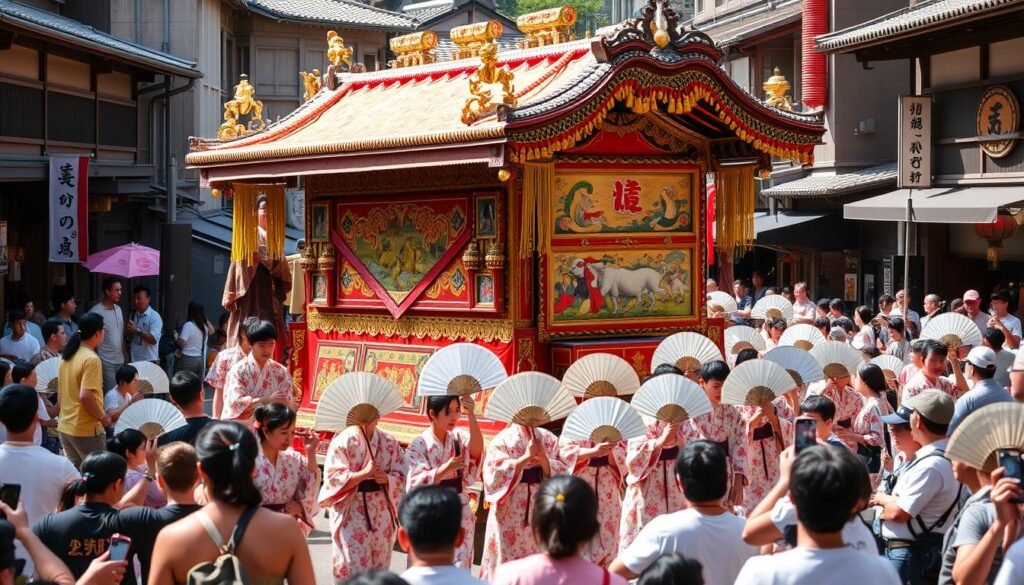
Gion Matsuri in Kyoto features elaborate floats and traditional processions
July Festivals
- Gion Matsuri (Kyoto)
All month, with main parades on July 17 & 24 - Tenjin Matsuri (Osaka)
July 24-25 - Sumida River Fireworks (Tokyo)
Last Saturday of July
August Festivals
- Aomori Nebuta Matsuri
August 2-7 - Sendai Tanabata Matsuri
August 6-8 - Awa Odori (Tokushima)
August 12-15
Fireworks Festivals
- Nagaoka Fireworks (Niigata)
August 2-3 - Edogawa Fireworks (Tokyo)
Early August - Miyajima Water Fireworks
Mid-August
Festival Tip: For popular festivals, book accommodations well in advance as hotels fill up quickly. Consider staying in nearby cities and taking day trips to festival locations if accommodations are full.
Essential Summer Travel Tips for Japan
Summer in Japan presents unique challenges and opportunities. Here are some final tips to ensure your summer trip is comfortable and enjoyable.
Beating the Heat
- Plan outdoor activities for early morning or evening
- Carry a small towel (tenugui) to wipe away sweat
- Use cooling wipes and sprays available at convenience stores
- Look for “cool spots” (air-conditioned public rest areas)
- Stay hydrated with sports drinks containing electrolytes
Summer Health
- Know the signs of heat exhaustion and heatstroke
- Apply sunscreen regularly, even on cloudy days
- Wear a hat and UV-protective clothing
- Carry insect repellent, especially near water or in rural areas
- Dial 119 for medical emergencies
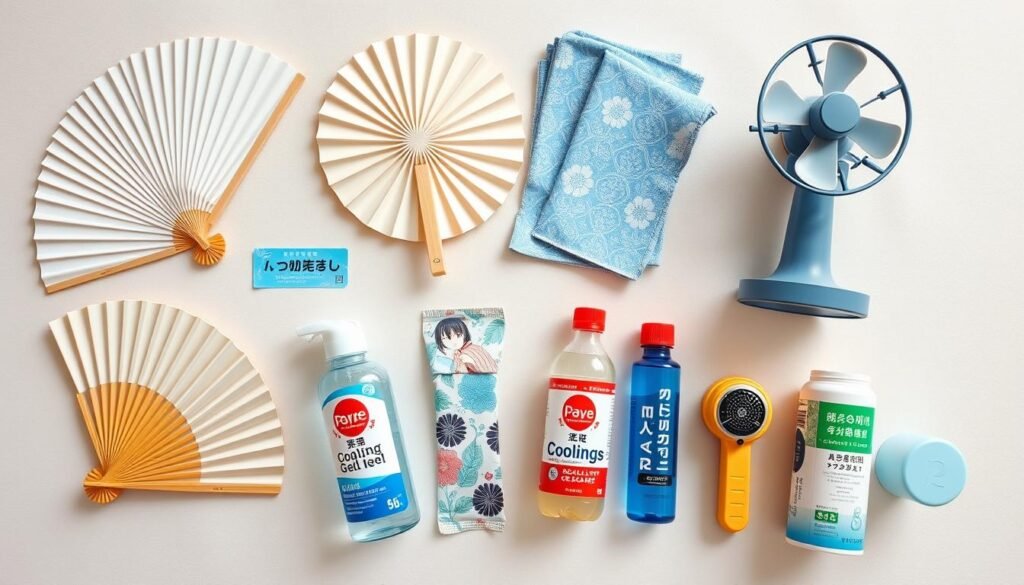
Essential cooling items for surviving Japan’s summer heat
Making the Most of Summer Specialties
- Summer Foods: Try seasonal specialties like hiyashi chuka (cold ramen), unagi (eel), somen (cold noodles), and kakigōri (shaved ice)
- Yukata Experience: Rent a yukata (summer kimono) in Kyoto or Tokyo for a traditional summer experience
- Evening Activities: Take advantage of extended summer daylight hours for evening sightseeing when temperatures are cooler
- Indoor Alternatives: Have backup indoor activities planned for particularly hot or rainy days
Language Tip: Learn a few heat-related Japanese phrases like “Atsui desu ne” (It’s hot, isn’t it?) and “Mizu o kudasai” (Water, please) to help communicate your needs during summer travel.
Frequently Asked Questions About Summer Travel in Japan
Is summer the worst time to visit Japan?
While summer in Japan is hot and humid, it’s not necessarily the “worst” time to visit. Summer offers unique experiences like festivals, fireworks, and fewer tourists at many attractions. With proper preparation for the heat, summer can be an excellent time to visit Japan, especially if you incorporate cooling activities and indoor attractions into your itinerary.
How crowded is Japan in summer?
Summer is generally less crowded than peak seasons like cherry blossom (late March to early April) and autumn foliage (November). However, popular summer festivals and the Obon holiday period (mid-August) can bring domestic tourists to certain areas. Major attractions in Tokyo and Kyoto will always have visitors, but summer crowds are generally manageable.
Can I see Mt. Fuji clearly in summer?
Summer is actually one of the more challenging times to see Mt. Fuji clearly due to haze and cloud cover. Your best chance is early morning before clouds form. However, summer is the only season when climbing Mt. Fuji is permitted (early July to early September). Even if visibility is limited, the Fuji Five Lakes area offers plenty of beautiful scenery and activities.
Is a 7-day Japan Rail Pass worth it for this itinerary?
Yes, a 7-day JR Pass is definitely worth it for this itinerary. The round-trip Tokyo-Kyoto Shinkansen journey alone (approximately ¥27,000) nearly covers the cost of the pass (approximately ¥29,650). Add in the trips to Nara, Osaka, and local JR lines in Tokyo, and you’ll save significantly with the pass.
How can I adjust this itinerary if I want to avoid the heat?
To minimize heat exposure, you can: 1) Schedule outdoor activities for early morning or evening, 2) Add more time in mountainous areas like Hakone or Nikko where temperatures are cooler, 3) Incorporate more indoor museums and shopping areas during peak afternoon heat, 4) Consider a day trip to Karuizawa, a popular summer resort town with cooler temperatures, or 5) Spend more time in air-conditioned department stores, museums, and restaurants during the hottest part of the day (1-3 PM).
Final Thoughts on Your 1-Week Japan Summer Itinerary
A summer trip to Japan offers a unique blend of cultural experiences, natural beauty, and festive celebrations that you won’t find during other seasons. While the heat and humidity present challenges, they’re easily managed with proper planning and the right mindset. This 1-week itinerary gives you a taste of Japan’s highlights while incorporating summer-specific activities and cooling strategies.
From Tokyo’s modern energy to Kyoto’s traditional charm, from Mt. Fuji’s majestic presence to Nara’s friendly deer, you’ll experience the incredible diversity that makes Japan such a fascinating destination. The summer festivals, evening illuminations, and seasonal foods add an extra dimension to your journey that visitors in other seasons miss out on.
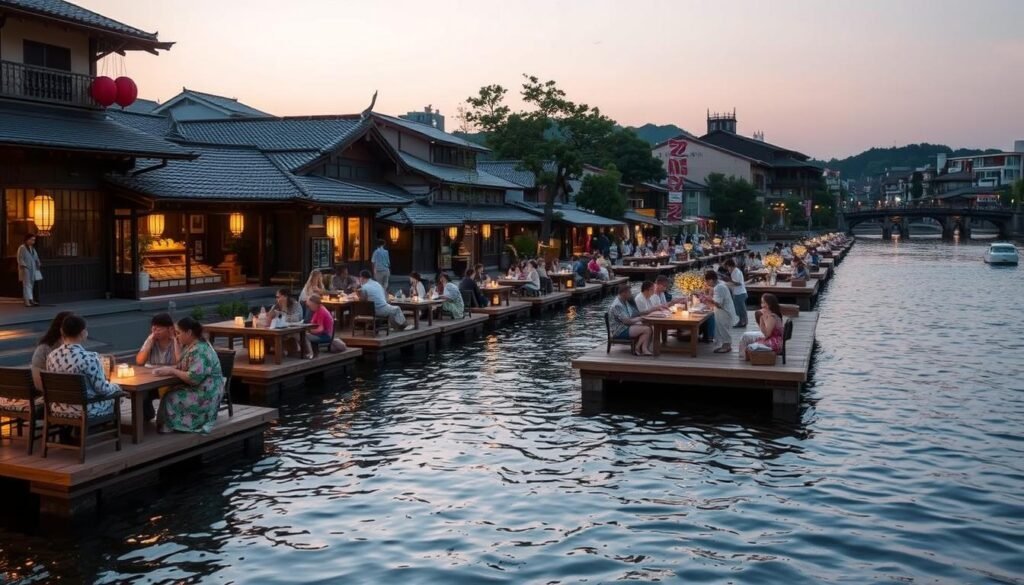
Riverside dining in Kyoto is a perfect way to enjoy summer evenings in Japan
Remember that flexibility is key when traveling in summer. Be prepared to adjust your plans based on weather conditions, and always prioritize your comfort and health. With the right preparation and this carefully crafted itinerary, your 1-week summer adventure in Japan will be filled with unforgettable experiences and memories to last a lifetime.

